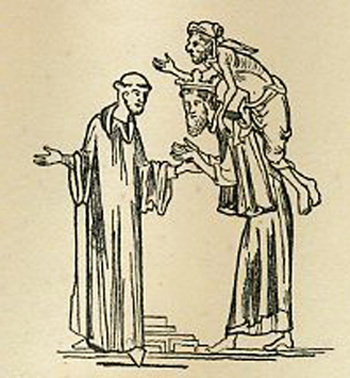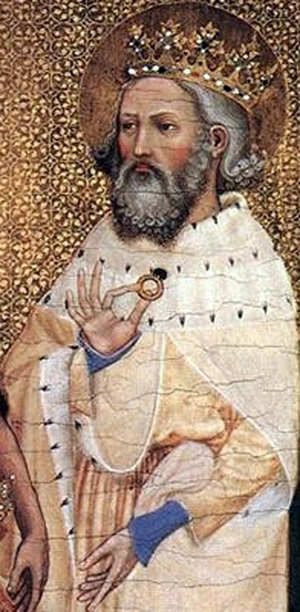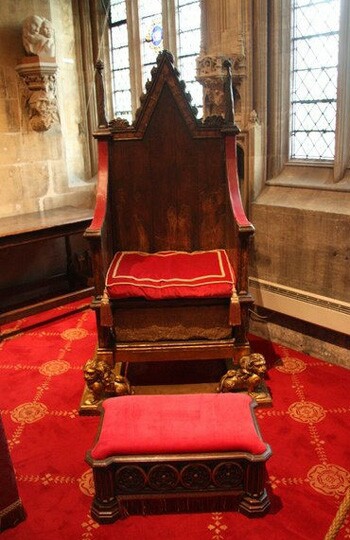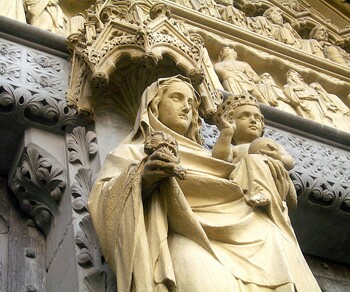 |
The Saint of the Day
St. Edward the Confessor, October 13
Prof. Plinio Corrêa de Oliveira
Biographical selection:
This story recounts how an Irishman named Gillemichel, who was crippled and covered with running sores, went to Rome seeking a cure for his wounds. The Pope told him that he would only be cured if King Edward of England (1003-1066) would carry him on his back from the great Westminster Hall to Westminster Abbey.
The pious Monarch consented. On the way, the sick Irishman felt as if his nerves were loosening and his legs becoming flexible. The blood of his wounds flowed on the King's regal attire, but the King continued to carry him to the altar of the Abbey. He was cured. He immediately walked and hung up his crutches at the Abbey as proof of the miracle that had taken place.
Comments of Prof. Plinio:

St. Edward carrying the beggar on his way to Westminster Abbey |
This was a man who had an illness that contracted his nerves, preventing him from walking, and whose body was covered with sores. He found a way to journey from Great Britain to Rome to ask the Pope to cure him. The Pope answered: “You will be healed if the King of England will carry you on his back on the road that goes from Westminster Hall to Westminster Abbey. Then, you will be cured.”
The man returned to Great Britain facing all the imaginable difficulties – travelling the interminable rugged roads with the constant threat of being assaulted by bandits, living off the meager alms he received, begging shelter at night in the monasteries and hostels along the way. He had to face all these adversities on his journey from Rome to England. And the worst part was that he had done this shortly before. The Pope sent him back, still unhealed, to face those hardships all over again.
It is beautiful to see the act of confidence the Pope had in the power of miracles of the King. It is also beautiful to see the peaceful resignation of the poor Irishman.
He travelled back to London and arrived at the Royal Palace. We can imagine the King with his Royal Diadem on his forehead and his stately attire seated on his Throne. St. Edward welcomed him with goodness and affability:
“What is that you wish?”

St. Edward the Confessor |
“My Lord, I was sent here by the Dominus Apostolicus (as the Pope was called at that time) and he told me that you would cure me.” Then he transmitted the message. The King agreed.
The contrast is enormous: On the one hand, a poor man, a semi-paralytic beggar covered with running sores; on the other hand, the healthy King in his glory and majesty. The Pope ordered nothing less than the King should carry this beggar on his shoulders and, in this humiliating act, walk publicly through the streets of the city. He was the Head of the Nation who should carry a sick and purulent man.
The King did it. He left the Palace, passing by the guards who probably duly saluted him; a bugle announced the King was leaving the Palace and his banner was lowered – a King’s banner flies only when he is present at the Palace; when he leaves the banner is lowered. He went by himself without any escort carrying that man on his shoulders to the great astonishment of the people who gathered around and started to follow the strange pair.
“What has happened? The King is not in his carriage. He is not on the magnificent steed he usually rides when he goes out. He is alone, without any guards or entourage, carrying this beggar on his shoulders...”
The episode caused a great sensation and the news spread quickly through the streets of the small London of the time.
People commented: “How can it be that this miserable beggar is riding on the shoulders of our King? Our holy King is being humiliated, he who is the symbol of all of England, the symbol of Catholic virtue. He, who is lofty, majestic and pure as a lily. How can it be that he walks alone with a beggar mounted on his shoulders? What an extravagant thing!”
The King recollected, continued along his path praying; the beggar was also deep in his prayers asking Our Lady to cure him. The surprised people followed in lines behind them to see what would happen.

The altar of Westminster Abbey, unfortunately today in the hands of Protestants |
As he continued, the King’s royal attire became stained with blood and pus from the flowing wounds. But the beggar began to feel movement in his limbs. They entered Westminster Abbey. I believe that there could be few scenes as beautiful as what was happening there.
The King arrived at the Altar and carefully removed the heavy load from his shoulders. The man who was mounted on the King’s shoulders was holding his crutches. But, then, he could walk without them. The sores were dried, he was cured. The King stood nearby, his apparel gloriously filled with blood and pus. A great miracle had taken place! The Royal Majesty blazed in one of the most beautiful acts of the whole history of Royalty in England. Through St. Edward, Our Lady worked a great miracle.
Now, the question: Is this episode true? Perhaps it is, perhaps it isn’t. It can be a myth or a legend. But this really does not matter too much. What matters is that multitudes of persons desired that things should happen in this way. That slowly the legend grew based on some residual truth. That the people became enthused with the possibility that this event could have taken place in this way. This ideal stirred the enthusiasm of the English people for whole generations. This is what matters: that this state of souls existed, that this mentality was alive.
However, perhaps it was true. Maybe the miracle took place just as it was described. Why could St. Edward not have worked such a miracle? But, from a certain perspective, it is less important to know whether the miracle happened than to know that the possibility of this miracle fed the flames of enthusiasm of the English people throughout History.
How different these multitudes were from the poor masses of our days…
Another question comes: What is the beauty of this story? The answer to this question is important for us to understand the beauty of the Catholic Church. Let us make a brief analysis so that this episode does not end by leaving only a fleeting impression but rather an enduring principle.
If the story were true, it was caused by the power of the Church, by the fact that St. Edward and the beggar belonged to the Catholic Church. If it were not true, it was grace that led millions of souls to thirst for such an ideal. Either way, it is the beauty of the Catholic Church that is reflected in this episode.

Throne of St. Edward; according to tradition the stone under the seat is the one over which Jacob slept |
This story has a twofold beauty:
One is the faith of the beggar. He is a poor man who, to be cured, innocently sets out to see the Pope and request the cure. It shows the prestige of the Papacy, how people believed that a Pope could work a miracle and effect a cure; we see the certainty they had of this.
He asks the Pope for a cure. The Pope could have cured the man, but he does not do so. He sends the beggar back to England. Our Lady was asking an act of confidence from the beggar that she normally only asks from men of strong faith. For the weak, she often comes to their immediate assistance. For the strong, she says a yes that has the appearance of a no.
Thus, the poor man drags himself back along the danger-ridden road until he reaches the Palace of the King. This beggar shows a great confidence that reveals the beauty of his faith.
Another beautiful thing in the story is the faith and submission of the King. The Pope ordered the King to do a thing that could easily appear extravagant. The King was known as a man who worked miracles. Why could he not cure the Irishman at his Palace?
Why did he have to carry that repugnant beggar on his shoulders? If it were necessary that they both go to Westminster Abbey, then, why should they not go seated in a carriage? But, no: the beggar had to go riding the King as if he were a horse. This seems to be an inversion in the hierarchical order.
However, we who love the order are also enthused to see that poor human rag riding the perfect, noble and holy King. Why? What is the beauty in this scene?
It is beautiful to see the public power in a role of domination. It is superb to pay due respect to those who hold the public power. Above all, this is true when the public power acknowledges the divine origin of the power in such way that, when we pay it homage, we pay homage to God, because we consider it to be a representative of God.
But, there is also beauty in another thing. On certain occasions it is beautiful to see the superior heroically demonstrating that he is the father of the inferior, to
see the strong offering the weak sustenance and assistance. For this reason, it is a beautiful thing for one who is higher and more powerful to serve the lower and the weaker, doing whatever is possible to cure him.

At the entrance of Westminster Abbey Our Lady seems stern, awaiting the conversion of the Anglicans |
Thus, we have two very beautiful things. A poor man resigned to his situation, who innocently asks the King: “Can I ride on your shoulders?” On the other hand, a King who knows how to be a king and knows the worth of his royal dignity, but who responds: “Of course, my son. Jump on my back and together let us ask for the miracle you seek.”
There is a profound harmony in this picture where one extreme touches the other. It is beautiful to see the highest of royalty touching the lowest of mendicancy. It is beautiful to see royalty carrying mendicancy to ask for a miracle before the altar of God. It is a great glory for God – the Author of the beggar and of the King – to draw from the presence of a man covered with sores, incapable of walking or making brilliant acts, an episode of perfect beauty that shines for the whole history of England, and for the history of mankind of all times.
The miracle crowns the episode. And we are left with our souls filled with nostalgia at contemplating a time when such events were possible, a time when the multitudes were charmed by episodes like this.
Let us retain in our hearts the principle that is behind this episode – the beauty of the opposite extremes that touch one another.
Let us forget for a moment the abominations of our times and think: What a great Pope, what a great King, what a great beggar! What a glorious beauty resides in the laws of the universe! How great is God Our Lord!


  |
|
Prof. Plinio Corrêa de Oliveira | |
The Saint of the Day features highlights from the lives of saints based on comments made by the late Prof. Plinio Corrêa de Oliveira. Following the example of St. John Bosco who used to make similar talks for the boys of his College, each evening it was Prof. Plinio’s custom to make a short commentary on the lives of the next day’s saint in a meeting for youth in order to encourage them in the practice of virtue and love for the Catholic Church. TIA thought that its readers could profit from these valuable commentaries.
The texts of both the biographical data and the comments come from personal notes taken by Atila S. Guimarães from 1964 to 1995. Given the fact that the source is a personal notebook, it is possible that at times the biographic notes transcribed here will not rigorously follow the original text read by Prof. Plinio. The commentaries have also been adapted and translated for TIA’s site.
|
Saint of the Day | Home | Books | CDs | Search | Contact Us | Donate

© 2002- Tradition in Action, Inc. All Rights Reserved
|
 |

|